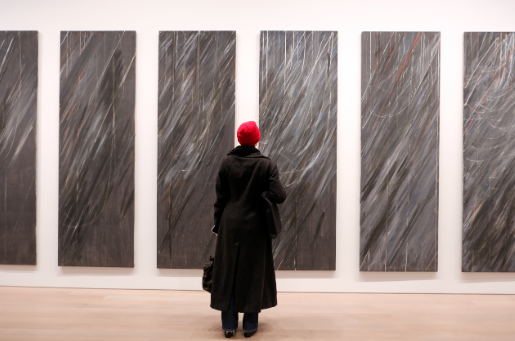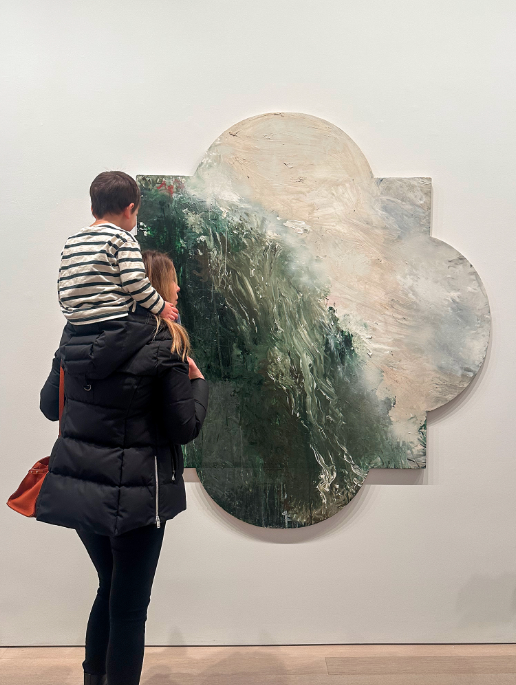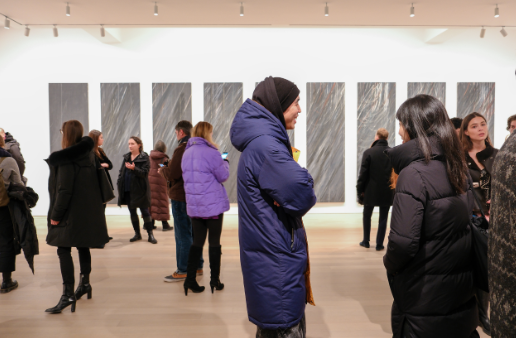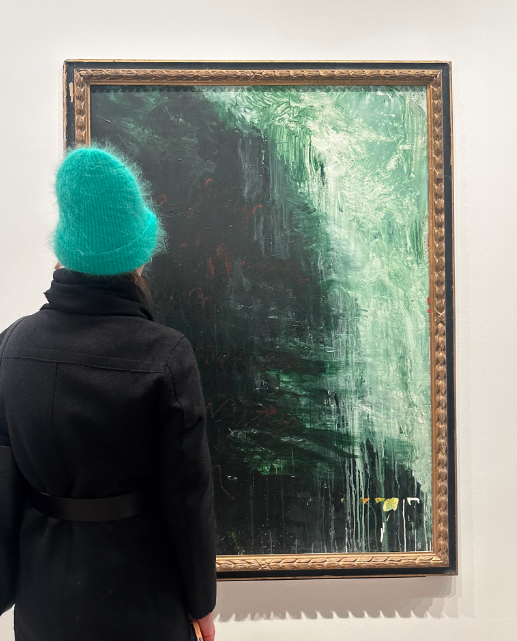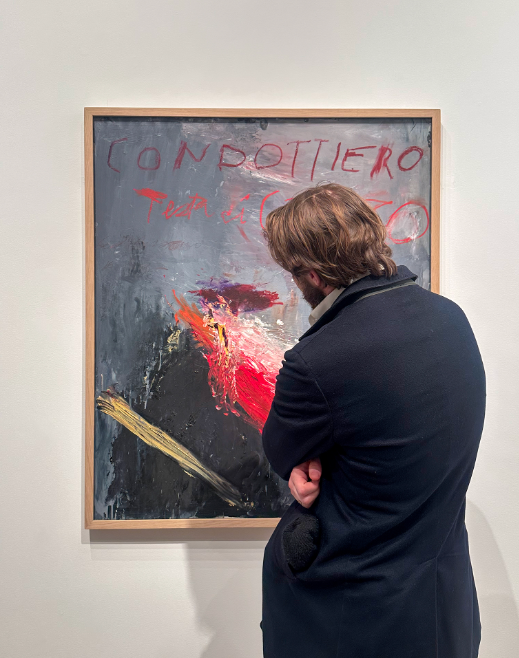Cy Twombly's Sublime Scrawl at Gagosian
A viewer admires a collection of untitled works from Twombly's blackboard series which were created in the late-60, early-70s. Photo by Jamie Lubetkin
It was in the early 1950s that Edwin Parker "Cy" Twombly Jr. first came to New York City from Virginia, eventually joining Robert Rauschenberg and Jasper Johns to form a downtown art triumvirate whose contributions to the evolution of contemporary rival any trio in history. Though Twombly would soon quit Gotham for Rome, there is no denying the influence the city had on him from his first show in 1957 to his time with fellow southerner Rauschenberg in a cold-water flat on Fulton Street.
Now, more than a decade after his death in 2011, Twombly's work returns to New York in an exhibition at Gagosian's Madison Avenue galleries, which opened Jan. 23. The show spans over two decades of his practice, from austere "blackboard" paintings of the late 1960s to vibrant floral abstractions from 1990, offering a fresh lens on an artist who straddled the worlds of ancient Mediterranean culture and American avant-garde innovation.
In an era when digital interfaces have made handwriting nearly obsolete, Twombly's gestural marks – hovering between writing and drawing, between meaning and pure expression – speak to something fundamentally human and increasingly rare. "His work embodies both the discipline of classical training and the freedom of pure gesture," wrote Kirk Varnedoe in his seminal 1994 MoMA retrospective catalog, articulating the tension that made Twombly's work so compelling.
A woman and a boy admire one of several quadrefoil paintings on display at Gagosian. Photo by Jamie Lubetkin
Born in Lexington, Virginia in 1928, Twombly arrived in New York at a pivotal moment. After studying at the Art Students League, he and Rauschenberg attended Black Mountain College in North Carolina, where they absorbed the revolutionary teachings of Franz Kline and Robert Motherwell. But while his contemporaries doubled down on American artistic independence, Twombly looked to the ancient world for inspiration.
In 1957, he made the radical decision to move to Rome, setting himself apart from the New York School just as it was achieving international prominence. This self-imposed exile would prove transformative. The Mediterranean light, the palimpsests of ancient graffiti, the weathered walls of Roman ruins – all these elements would seep into his work, creating a unique fusion of American gestural abstraction and European cultural memory.
The line to get into the Cy Twombly show at Gagosian's Madison Ave. Gallery curled twice around the lobby and threatened to send some into the street. These art lovers got in early. Photo by Jamie Lubetkin
The current exhibition's "blackboard" paintings from 1968-71 reflect a period when Twombly, though based in Italy, was in close dialogue with Minimalist and Conceptual developments in New York. Their repeating loops and mathematical notations suggest both classroom exercises and the automatic writing of the Surrealists. One particularly striking 1968 canvas evokes Leonardo da Vinci's drawings of floods and maelstroms, transforming Renaissance naturalism into pure kinetic energy.
A woman looks at "Paesaggio," one of a group of landscape abstractiions Twombly painted in the 1980s. Photo by Jamie Lubetkin
The show's later works reveal Twombly's increasing immersion in Mediterranean culture. A series of green paintings from the 1980s, created in his studio in Bassano in Teverina, capture the verdant Italian landscape in abstract terms. Their quatrefoil formats nod to Rococo decoration while their drips and splatters maintain a connection to Abstract Expressionist spontaneity.
Among the most intriguing of the landscapes is "Paesaggio" (Italian for landscape), a 1986 work of acrylic on panel. In this dramatic landscape, Twombly pushes further into dark abstraction while maintaining a clear reference to nature. The painting is dominated by a looming, almost ominous dark green mass that suggests a mountainside or dense forest. The drips and vertical streaks, characteristic of Twombly's technique, evoke rain or mist cascading down the landscape. The contrasting turquoise sky at the top provides a luminous counterpoint to the shadowy terrain below. "Paesaggio" demonstrates Twombly's late-career mastery of balancing atmospheric effect with gestural abstraction, creating a work that feels both primordial and deeply personal.
Also historically significant and fascinating is the reunion of "Five Day Wait at Jiayuguan" (1980), a suite of works on paper not seen together since the 39th Venice Biennale in 1980. Created after Twombly's travels through Central Asia, these pieces demonstrate how he transformed direct observation into poetic abstraction, incorporating both Western and Eastern calligraphic traditions.
A man considers a 1988 work by Twombly, "Condottiero Testa di Cozzo," which references Italian renaissance portraiture. Photo by Jamie Lubetkin
The exhibition includes "Condottiero Testa di Cozzo" (1987), a painting that references Titian's portrait of the Duke of Alba while reducing Renaissance portraiture to its essential chromatic and gestural elements. This dialogue between past and present, between representation and abstraction, exemplifies Twombly's unique position in art history.
Throughout his career, Twombly maintained connections to New York while keeping it at arm's length. His first solo show at the Stable Gallery in 1957 received mixed reviews, but by the 1980s, his influence on younger artists was undeniable. Julian Schnabel, Jean-Michel Basquiat, and others drew inspiration from his fusion of text and image, his embrace of classical references, and his uninhibited mark-making.
The current exhibition, organized with the Cy Twombly Foundation, includes previously unseen works and loans from the Twombly family, offering new perspectives on an artist who helped expand the possibilities of abstract painting. In an age of digital perfection, Twombly's handmade marks, his erasures and pentimenti, his marriage of classical culture and modernist freedom, feel more relevant than ever.
As Twombly once said in a rare 1994 interview with David Sylvester: "I'm not a professional painter, since I don't go to the studio and work nine to five like a lot of artists. When something hits me, or I see a painting, or when I see something in nature, it gives me a thing and I go for it."
That "thing" – elusive, poetic, deeply personal yet universal – continues to resonate through these Madison Avenue galleries, reminding us of art's capacity to bridge time, culture, and human experience.
Cy Twombly runs through March 22 at Gagosian, 980 Madison Avenue, New York

